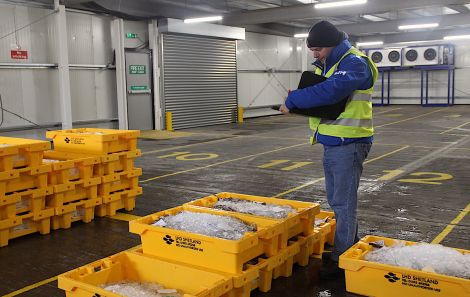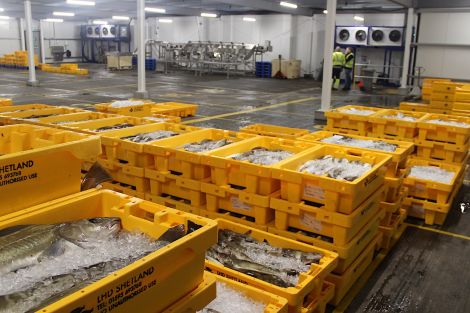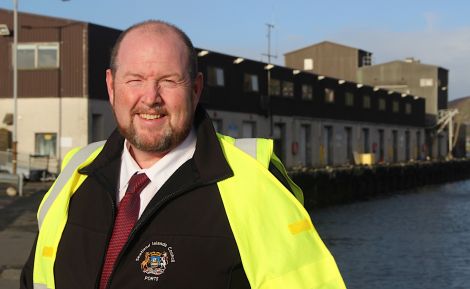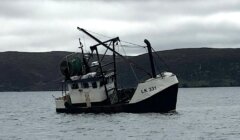Business / Fish landings at Scalloway continue while new market is built
SCALLOWAY’s ‘new’ interim fish market is now operational ahead of Shetland Islands Council (SIC) awarding a £5.6 million contract to demolish the old market and build a new state of the art facility at Blacksness Pier.
The temporary fish market has been built within one of the large warehouses on the pier to ensure fish landings on the westside of Shetland can continue uninterrupted during the 18-month construction period of the new market.
Almost half of all fish landed in Shetland these days is put ashore on council piers at Scalloway and Cullivoe, with last year’s 190,000 boxes of whitefish a far cry from the depressed times of 15 years ago when just 15,000 boxes were handled at Blacksness.
Meanwhile, construction of a new fish market for Lerwick is well underway at Mair’s Quay as fish landing at the east side of Shetland grows steadily year on year.
Overall 403,000 boxes of fish were landed in Shetland in 2017, a figure that is set to grow even further to an estimated 450,000 boxes by Christmas this year.
White fish landings are providing a major stream of income for the SIC, earning the local authority around £400,000 in landing dues per year.
SIC infrastructure director John Smith said investing in modern and larger fish market facilities was the next logical step in supporting the fishing industry to produce a quality product that is demanding premium prices.
“The sensible next move was for both Scalloway and Lerwick to upgrade their very old and tired facilities with new capacity and increase the quality as any fish market is increasingly a food processing facility rather then a shed,” he said.
Become a member of Shetland News
Scalloway harbour master Greg Maitland said the port and its users had looked at a number of different scenarios to keep the market open while the new facility was being built.
“I think everybody is very pleased with what we have managed to accomplish in the temporary facility,” he said.
Maitland said the interim market would also serve as a test ground to help iron out any of the teething problems that will inevitably come up when introducing a new facility.
“When we will hit the ground running with the new market we should have a very good idea of how to operate it,” he said.
Following a number of successful trials earlier in October, fish were sold from the interim facility for the first time on Thursday morning.
At 750 square metres open plan the interim market is a fair bit larger than the old market and is also laid out in a more convenient and modern way.
It meets all modern hygiene requirements and also houses the grading facilities, which have become a major contributor to the high prices achieved for fish landed in Shetland.
Managing director of Shetland Seafood Auction, Martin Leyland, said the interim facility already making the grading progress of fish more efficient and less labour intensive.
Fish buyer Karl Simpson said that given the ever-increasing volume of landings and the premium prices achieved, the interim market development was “absolutely essential” for the industry.
“The interim facility is first rate, indeed they appear to have been very fortunate to have secured such a good building, so close to the harbour. The size is perfect – its nice and wide, indeed the kind of width that would be ideal for the new market,” he said.
“They have got all the facilities for bootwash and handwash in place, so as buyers we are on the whole very happy with the new arrangement.”
The new market, meanwhile, will be built on the site of the old one at the east side of Blacksness. With near to 1,500 square metres in floor space and a capacity of up to 3,500 boxes of fish per day it should be capable of catering for future growing demand.
The SIC is hopeful an application for EU funding of up to 50 per cent of the overall cost will be successful, but it felt it had to award the contract ahead of a final decision in order to get the construction completed by March 2020, as stipulated by the European Maritime and Fisheries Fund.
With the quality of the whitefish landed in Shetland now recognised throughout Europe, the new fish markets for both Lerwick and Scalloway will be able to cope with larger quantities, although some voices are already suggesting the new markets could quickly prove to be too small.
However, long before the focus has to shift to Shetland’s external transport links – that is increasing capacity and improving flexibility on the Northern Isles ferry service but also the uncertainty of getting fresh seafood into Europe once the UK has left the European Union, with or without a deal.
SIC infrastructure boss Smith described external transport as the “choke point” – and that is not just the Aberdeen ferry route.
“Getting the fish out of Shetland, across the UK and into Europe, is critical at the moment, because that is where people are buying our fish,” he said.
Depending on the composition of the whitefish landed on any one day, between 25 and 30 per cent of fish is dispatched to the Eurozone, and sometimes as much as 50 per cent.
“Almost every fish buyer in the UK, Ireland and near the continent will have some kind of representation on the Shetland market. The quality is recognised and as a result it is tremendously competitive,” Simpson said.
Become a member of Shetland News
Shetland News is asking its readers to consider paying for membership to get additional perks:
- Removal of third-party ads;
- Bookmark posts to read later;
- Exclusive curated weekly newsletter;
- Hide membership messages;
- Comments open for discussion.
If you appreciate what we do and feel strongly about impartial local journalism, then please become a member of Shetland News by either making a single payment, or setting up a monthly, quarterly or yearly subscription.














































































